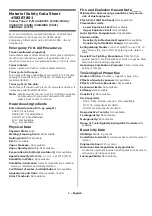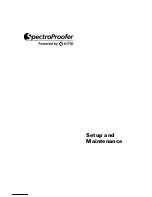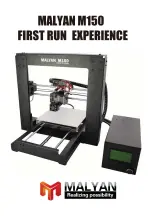
Operating Principles
Rev. A
2-1
2.1 Printer Mechanism Operating Principles
This chapter describes the operating principles of the printer mechanism (M-5P60).
2.1.1 Printing Mechanism
Printhead
The printing mechanism of this printer is composed of the 24-pin impact dot printhead
and a ribbon mask. The printhead has 12 pin wires in each of 2 rows, which are aligned in
an rhombic layout. (See Figure 1-2 in Chapter 1.) Each wire has its own drive coil.
S t o p p e r
A c t u a t i n g P l a t e
A c t u a t i n g S p r i n g
H e a d D r i v i n g C o i l
I r o n C o r e
P a p e r
W i r e R e s e t t i n g S p r i n g
D o t W i r e
I n k R i b b o n
R i b b o n M a s k
P l a t e n
Figure 2-1. Structure of the printhead
Printing process
1. The printing signal transmitted from controller circuit to the head driver circuit is
converted into the head drive voltage, which energizes a corresponding coil. The
energized coil then magnetizes the iron core.
2. The magnetized iron core draws the actuating plate which joins to the dot wire. This
movement rushes the wire toward the platen.
3. When the dot causes impact to the platen, it presses the ribbon to the paper, where a
dot prints.
4. When the coil energizing is terminated, the iron core, losing magnetic force, is returned
to the standby position by the bounce of the platen and tension of the actuating spring.
The printing mechanism has an integrated thermistor to detect head temperatures. The
detected temperature is converted into an electrical signal and fed back to the controller
circuit. This information as well as paper thickness is used as a basis for determining
printhead driving mode to ensure high printing quality. It is particularly important to keep the
head temperature at a proper level constantly to minimize burning and deterioration of the
dot wires in the printhead, which are caused by the rise in the head temperatures due to
continuous printing. When the head temperature is below the specified level, the appropriate
driving mode is selected based on the detected temperature to keep the wires respondent.
(Refer to Section 1.3.1 in Chapter 1.) See Table 2-1 in Page 2-2 for the printhead
specification.
Summary of Contents for DLQ-3000+
Page 1: ...EPSON EPSON EPSON France S A SERVICE MANUAL DLQ 3000 PRODUIT ...
Page 2: ...EPSON 24 PIN DOT MATRIX PRINTER EPSON DLQ 3000 SERVICE MANUAL SEIKO EPSON CORPORATION 4008259 ...
Page 6: ...v REVISION SHEET Revision Issued Data Contents Rev A August 21 1997 First Release ...
Page 62: ...2 3 12 Other Sensor Circuits 2 30 ...
Page 160: ...Chapter 6 Maintenance 6 1 Maintenance 6 1 6 1 1 Lubrication and Adhesion 6 1 ...
Page 171: ...DLQ 3000 Rev A A 6 ...
Page 172: ...Appendix Rev A A 7 A 2 Circuit Diagrams Figure A 2 C210 MAIN Board Circuit Diagram 1 2 ...
Page 173: ...DLQ 3000 Rev A A 8 ...
Page 174: ...Appendix Rev A A 9 Figure A 3 C210 MAIN Board Circuit Diagram 2 2 ...
Page 175: ...DLQ 3000 Rev A A 10 ...
Page 177: ...DLQ 3000 Rev A A 12 Figure A 5 C124 PSB Board Circuit Diagram ...
Page 180: ...Appendix Rev A A 15 Figure A 8 C210 MAIN Board Component Layout 2 2 ...
Page 181: ...DLQ 3000 Rev A A 16 Figure A 9 C124 PSB Board Component Layout ...
Page 182: ...Appendix Rev A A 17 Figure A 10 C124 PSE Board Component Layout ...
Page 189: ...EPSON SEIKO EPSON CORPORATION ...
Page 254: ...PC 437 USA Europe standard Annexe A 27 ...
Page 255: ...PC 850 Multilingue PC 860 Portugais PC 863 Français canadien PC 865 Norvégien A 28 Annexe ...
Page 256: ...PC861 Islandais BRASCII Portugais brésilien Abicomp Portugais brésilien Annexe A 29 ...
Page 259: ...A 32 Annexe ...
Page 262: ...Utilisation du sommaire des commandes A 10 V Vitesse 2 25 W Windows Microsoft 1 17 18 Index 3 ...
















































